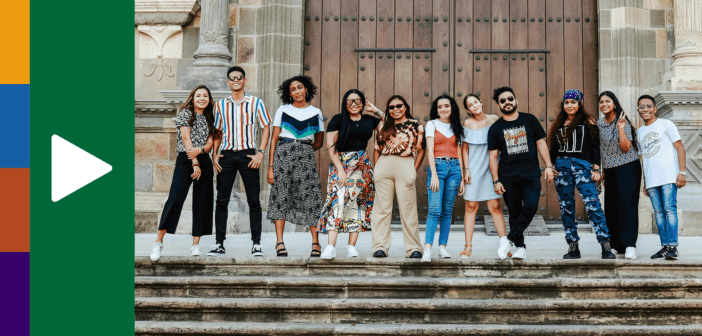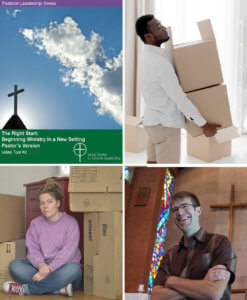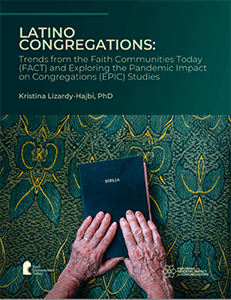
How are the trends in majority Latino congregations different from those in non-Latino congregations? We speak with Kristina Lizardy-Hajbi about her report Latino Congregations: Trends from the Faith Communities Today (FACT) and Exploring the Pandemic Impact on Congregations (EPIC) Studies. It reveals that while Latino congregations face financial difficulties, a majority have experienced growth or remained stable in recent years.
Listen on Apple Podcasts | YouTube Music | Spotify
Watch on YouTube

Read in-depth interview
- Transcript — Click or Tap to Read
-
Announcer: Leading Ideas Talks is brought to you by the Lewis Center for Leadership of Wesley Theological Seminary in Washington, DC. Subscribe free to our weekly e-newsletter, Leading Ideas, at churchleadership.com/leadingideas.
Leading Ideas Talks is also brought you by The Right Start. If you’re a pastor preparing to begin ministry in a new setting, this video tool kit will lead you in ending your current ministry well, developing a personal transition plan, and making the most of your first days, weeks, and months in your new congregation. Learn more and watch a preview video at churchleadership.com/therightstart.
How are the trends in majority Latino congregations different from those in non-Latino congregations? In this episode we speak with Kristina Lizardy-Hajbi about her new report. It reveals that while Latino congregations face financial difficulties, a majority have experienced growth or remained stable in recent years.
Jessica Anschutz: Welcome to Leading Ideas Talks, a podcast featuring thought leaders and innovative practitioners. I am Jessica Anschutz, the Assistant Director of the Lewis Center for Church Leadership, and I am your host for this Leading Ideas Talk. Joining me is Kristina Lizardy-Hajbi, an ordained minister in the United Church of Christ, Assistant Professor of Leadership and Formation, and Faculty Director of the Office of Professional Formation at Iliff School of Theology. She’s an interdisciplinary scholar who teaches in the fields of leadership theory and praxis, congregational and community formation and change, practical theology, and applied research methods. The focus of our podcast today is trends in Latino congregations drawing on a report she authored: Latino Congregations: Trends from the Faith Communities Today (FACT) and Exploring the Pandemic Impact on Congregations (EPIC) Studies. Welcome Kristina, I look forward to our conversation today.
Kristina Lizardy-Hajbi: I do as well, Jessica. Thank you for having me.
Jessica Anschutz: As we get started, I invite you to share with our audience a little bit about the background behind the report on the state of Latino congregations today.
Kristina Lizardy-Hajbi: Yeah, so the report analyzes data from two research efforts, which you just heard in the title of the report. The first survey is called the Faith Communities Today survey, and it is a national survey of congregations that has been taking place since the year 2000. It’s a periodic survey that takes place. The report analyzes data from the 2020 FACT national survey, which had over 15,000 congregations overall reporting in this survey. The second study where the analysis from this report comes from is the Exploring the Pandemic impact on Congregations, or the EPIC research project, which is a five-year project seeking to analyze and look at the effects of the COVID pandemic on congregational life in the United States. This project involves not only national surveys but also panel surveys following particular congregations over time, and nearly 100 regional case studies, local case studies, of congregations themselves across nine regions. So, a hundred case studies across nine regions of the country. Both of these research efforts are organized and housed at the Hartford Institute for Religion Research out of the Hartford International University for Religion and Peace, which used to be Hartford Seminary.
Jessica Anschutz: Wonderful, thank you so much for that. Before we dig into the report, I think it might be a little helpful for our listeners to know just a little bit of background about the Latino population in the United States. What would you say is key for our listeners to know as we move into talking about these studies?
Kristina Lizardy-Hajbi: I would say that Latinos in general are very similar in terms of the broad breadth of diversity, country of origin, ethnicity, as you would find in any other particular grouping. So, Euro Americans, Indigenous peoples, Asians, Asian Americans, they are not a monolith. But I will say, as we categorize ourselves in the United States, we are peoples who generally trace our heritage to Central and South America, Spain, and/or the Caribbean.
We constitute about 18% of the total U. S. population, and that’s based on the 2020 U. S. Census survey. We are the second fastest growing racial and ethnic group, right behind Asians. We constituted about half of all growth from 2010 to 2020 in the U. S. population.
As we are not a monolith, we speak a variety of languages. Many of us are bilingual, so English, Spanish, Portuguese, and a host of indigenous languages that come from all across the southern western hemisphere. Another thing I’ll share is that we name and call ourselves by many different monikers. So, I will probably, for the purpose of our conversation, use Latino, just because that’s easier to say. But there are gender inclusive terms like Latinx or Latine, which is a newer one. We also are referred to as Hispanic or call ourselves Hispanic. Then of course we have the ethnic and national specific kinds of ways that we talk about ourselves. So, I’m Puerto Rican, so I’m Puertorriqueña. There’s Cuban, there’s Mexican, Chicano, and so on and so forth.
Jessica Anschutz: Thank you so much for sort of setting the stage for our conversation. When it comes to the research, what are some of the key findings that you would highlight for church leaders today?
Kristina Lizardy-Hajbi: Well, there are lots of key findings in this report, but I want to share just one to begin us. I think this is unique and a unique aspect of Latino congregations in general, apart from other congregations in the United States. A majority, 6 out of 10, Latino congregations have experienced growth or remained stable in attendance over the past five years. That is a very different picture than for other congregations as a whole. Over half of other congregations have declined in the last five years in terms of attendance. And there are likely a number of reasons for this. One of the main reasons is simple demographic shifts within the U. S. as a whole. So as the Latino population increases, as other minoritized populations increase, there will likely be growth in congregations.
Same with the decline in terms of congregations that are declining, and many of them are Euro American congregations. That is because of, again, demographics. There are other factors such as secularization and those sorts of things that take place as well, but I find it a really interesting factor because Latino congregations are an increasingly vibrant aspect of congregational life in the U.S. and they trend younger than other congregations as a whole too, which is another demographic piece around that.
Jessica Anschutz: I found that really interesting, not only the growth, but the reality that they’re younger and also are doing a better job of using technology.
Kristina Lizardy-Hajbi: Yes. Absolutely. The median age of majority Latino congregations is much younger than other congregations. These congregations use more informal means of communication such as social media, email (perhaps not even emails but sometimes emails), but texting is it is an important one and the use of texting apps such as WhatsApp. These were shown to be used at higher rates and more frequently with Latino congregations than other congregations. More formal means of communication like newsletters, for example, were used less frequently in Latino congregations. I do think there is something there with age, and there’s something there with the informality of it, right? Versus the more formal ways that congregations have historically communicated with members.
Jessica Anschutz: I appreciate you highlighting that. I found the age difference really surprising and enlightening. I think it makes a lot of sense, but it also makes me think that non-Latino congregations have a lot to learn from Latino congregations as far as reaching younger generations and younger people.
Kristina Lizardy-Hajbi: Absolutely. At the same time, I always want to say to other congregations and congregations that trend older that it’s not your fault because also demographics play a huge role in this as well. So, Latinos as a whole trend younger than Euro American populations, for example, right? Because of new immigration and younger families that come into that sphere, and the increase over the last decade alone, those are huge factors that often I think other congregations tend to place the burden on themselves for “why don’t we have more young people?” Sometimes there’s just not a ton of young people to be had in certain areas and in certain demographics.
Jessica Anschutz: That is certainly true. I want to jump in a little bit into the affiliation of the Latino congregations, because some of that data really surprised me. Seven out of 10 majority Latino congregations are evangelical Protestant. What surprised me was that only 12.8% were Catholic and Orthodox and 15% were mainline Protestant.
I was mostly surprised about the Catholic number, but then I realized that Catholic churches are home to 33.8% of all Latino congregational worshipers. So, they have a higher percentage of worshipers in a smaller percentage of congregations. Mainline Protestant churches are home to only 4.4% of worshipers with evangelical Protestant churches being home to 61.7% of Latino congregation worshipers. What does this tell us about majority Latino congregations?
Kristina Lizardy-Hajbi: It seems a little confusing when you first talk about it in terms of the share, but what this means is that evangelical congregations have a larger share of the total participants among these congregations and an over representation above the percentage of those congregations that actually exist. And that’s true for Catholic congregations as well. So, even though they are only 12.8% of congregations as a whole, Catholic and Orthodox parishes, they have a third of all participants, which means that they’re larger, right? And many Catholic parishes tend to be larger and have several masses and types of services. This is also true for evangelical congregations who constitute, you know, as you said, seven out of 10 total congregations for Latinos.
What it means for mainline Protestant churches then is that they are smaller. They are smaller overall than these other two types of congregations because they only have 4% of the share of total participants, even though they’re 15% of the total number of congregations as a whole.
So, it’s just a different way to look at size and how that plays out in terms of participants. Evangelical Protestant is a big tent. That includes Southern Baptists, it includes certain denominations, but denominations that also identify within the evangelical tradition.
If you’re a pastor preparing to begin ministry in a new setting, The Right Start Video Tool Kit leads you in ending your current ministry well, developing a personal transition plan, and making the most of your first days, weeks, and months in your new congregation. Available in Pastor’s and Group Training Versions. Learn more and watch a video preview.
Jessica Anschutz: Thank you for helping us under understand those numbers. As we’re talking about Latino congregations, geographically speaking where are they located in the United States?
Kristina Lizardy-Hajbi: Overall, I would say that the patterns match the regions of the country that are also more churched in general. There are some nuances to that with majority Latino churches, but six out of 10 majority Latino congregations are located in the South. About half of all other congregations are located in the south as well.
You see this concentration in an area where it is heavily churched. But when you look at states like Florida that have a lot of Latinos, this makes sense as well. In the West, for example, which is less churched, only two out of 10 Latino congregations are in the Western U.S. But because you have California and Arizona, and there are large concentrations of Latinos there, a greater percentage of Latino faith communities are found in these places than non-Latino faith communities, which is interesting to note. So, again, there are some patterns that we see with churches overall, but really some nuances there to say, yeah, a lot of Latinos in those regions go to church. There’s a greater percentage of these congregations in these areas than other congregations.
Jessica Anschutz: As we think about congregations, that also makes me think about property. And I found it interesting that Latino congregations are half as likely to own their own facilities and three times more likely to worship in the same building as other congregations. Talk to us a little bit about this, what this means, what this looks like.
Kristina Lizardy-Hajbi: There, again, I’m just speculating, but there are a lot of factors and reasons for this to be the case. One of them is that the data showed that the median founding date of majority Latino congregations is 1991. That is 50 years later than the median of all other congregations. So not having had time to build resources, to build capital, is perhaps one factor.
Another factor is because the Latino population is also a significantly immigrant population, is continuing, and is a huge part of our growth from other countries, according to the census as I shared: there is not that time to build generational wealth and there hasn’t been yet. I suspect that that will change as we move forward, and this affects congregations in lots of different ways.
This means that Latino churches are renting facilities from other congregations, meeting in the building is perhaps more established churches as well. Some of them are not paying rent at all. Others are even meeting in homes or other spaces that aren’t congregations.
There’s a wide variety of ways that folks are meeting and coming together. Of course, finally, you do have the group of congregations that own their own facilities or their denomination or their tradition owns their own facilities, which is true, certainly of dioceses, for example, in the Catholic tradition. It’s just all very fascinating because there’s opportunity there for partnership, for learning, especially if a Latino congregation is meeting in someone else’s building or a space that has become shared.
Jessica Anschutz: Let’s talk a little bit about pastoral leadership. In many traditions, we are seeing an increase in bivocational ministers. What I found really interesting about the research is that many more Latino pastors are bivocational.
Kristina Lizardy-Hajbi: I know that the, at least the Faith Communities Today survey and I think the EPIC surveys don’t, I don’t know if they use the word bivocational specifically, but they ask leaders, “do you have other kinds of paid employment outside of your congregation?” Over one third of pastors of majority Latino congregations say that they have paid employment regardless of whether their roles are full-time or part-time, and regardless of whether their roles are paid or unpaid.
So, two in 10 pastors of these churches are unpaid in their current roles. Knowing from some of the local case studies that I’ve done and that my team has done in the Denver region. There’s one pastor, for example, of a Presbyterian church who doesn’t get paid for their role as the pastor of the church. They have a full-time job outside of that, but yet they are the pastor of this Spanish speaking new church start. So, there are lots of different configurations here, but the incidences of bivocationality or multivocationality are certainly higher in majority Latino congregations than other congregations.
I also want to say that I keep saying majority Latino congregations because that was the way that I analyzed the data. Congregations that had at least 50% or more of their participants identified as Latino were included in the survey. But that could mean that there were other ethnicities, other racial identifications within those congregations.
That kind of translates into the findings that we found about the racial identities of the leaders themselves. So, only four in 10 key leaders of these Latino congregations are actually Latino themselves. Four in 10 were identified as white, which is very interesting and very fascinating. So, I just note that to say there’s a lot of diversity, even within these congregations, racially and within the leadership. What are the dynamics of a white leader in a majority Latino congregation? And then there were, you know, what about an African or Afro Caribbean leader of a congregation? They may actually represent other ethnicities or nationalities present in the congregation too.
Jessica Anschutz: It’s so interesting, and I think there’s such great diversity that isn’t apparent, right, in the numbers and the terminology that we use. Based on the research, what would you say is needed for greater vitality in Latino congregations?
Kristina Lizardy-Hajbi: Hmm. I don’t know if, I just don’t know at this point because these congregations also report greater vitality than other congregations as a whole, and that’s defined in the surveys in lots of ways. You know, do they have a clear sense of mission and purpose? Are they willing to meet new challenges? Are they good at incorporating new members? What is their level of involvement in their local community? Those are all markers of what we would look for in terms of the survey data. Are they more spiritually, or do they say they’re more spiritually vital and alive, for example? These congregations do over and above other congregations. So, the question of vitality really has to do with sustainability, which is a different question and has to do around property and finances and staffing and what will it take for these ministries to continue into the future. So, I would answer it that way. I would break it down a little bit in terms of vitality versus sustainability.
Jessica Anschutz: That’s fair. I know that Latino congregations did report greater financial difficulties both pre-lockdown, pre-COVID, and a sort of decrease in giving. You were talking about the vitality of congregations, and it was striking to me that only one in 10, or 10.9% of Latino congregations experienced major conflict and that conflict tends to impact Latino congregations less severely overall when they are compared with majority non-Latino congregations. Do you have any thoughts on why this might be the case?
Kristina Lizardy-Hajbi: I do. Part of me wonders, is it the case that it’s underreported? So, is it a reporting bias that people don’t want to report that there’s conflict? Is it a question of what is considered conflict? If it’s not open conflict, is it actually conflict? There might be some cultural differences for how conflict is understood. So that’s all part of like survey bias questions and things like that. But overall, I haven’t drawn these correlations, and I don’t know if this is statistically accurate, but because a large percentage of these congregations are either stable or growing, that might be a reason for having less conflict.
That’s not to say, however, that stable and growing congregations don’t have conflict at all because they certainly do. Growth, especially if there’s an established group of people in the congregation, [brings]new people [who]often bring new ways of doing things and bring conflict. But because these are newer congregations, perhaps there hasn’t been that level of conflict that you might have with a more established group and then newer people coming in.
So that might also be a reason for these fewer percentages of, of conflict that we see in Latino congregations.
Jessica Anschutz: I could also see it being the case since they trend younger, you don’t have some of the generational conflicts that come in other contexts.
Kristina Lizardy-Hajbi: Yes. Yes, absolutely.
Jessica Anschutz: Before I draw to a close, I would like to give you an opportunity to share with our listeners where folks can find this report.
Kristina Lizardy-Hajbi: Yes, thank you. There are two places that you can find this report, and we have versions both in English and in Spanish. They can be found on the websites of both of these studies. So, for the Faith Communities Today Study or the FACT study, the website is www.faithcommunitiestoday.org and for the EPIC study Exploring the Pandemic Impact on Congregations project, that website is www.covidreligionresearch.org. These are free reports, downloadable, and you’ll also find lots of other reports. There are a number of really interesting reports coming out of the EPIC project around clergy impacts or impacts on mental wellness of clergy after COVID 19, studies on technology use after COVID 19. So, there’s a lot there.
Then with the faith communities today’s study, I think they’re actually in the process of doing another round of surveys among religious bodies, or getting ready to do one. So there are lots of reports on that website as well, if you’re interested in these national surveys of religious life and congregational life.
Jessica Anschutz: Thank you so much for lifting that up. I will make sure that we include those links in the transcript and in the notes the podcast so that our listeners can access them easily. I want to thank you, Kristina, for taking the time to talk with me today. As we draw to a close, I want to invite you to share your hope for Latino congregations as we move into the future.
Kristina Lizardy-Hajbi: My hope would be increased financial stability and the ability to find stable spaces and places for worship and service in their local communities. My hope alongside that is that denominations and religious bodies can direct financial resources and properties the way of Latino congregations, particularly those denominations that have those resources and as certain other populations decline, that those get redistributed in equitable ways.
Don’t forget to subscribe to our free weekly e-newsletter, Leading Ideas, to be notified when new episodes are published. Visit churchleadership.com/leadingideas.
Related Resources
- The Pandemic’s Real Impact on Clergy and Congregations featuring Scott Thumma — Leading Ideas Talks podcast episode | Podcast video | In-depth interview
- 2020 Faith Communities Today Overview
- Exploring the Pandemic Impact on Congregations Project
- Increasing Interest in Bivocational Ministry, a report from the Religious Workforce Project
Photo by Luis Quintero






